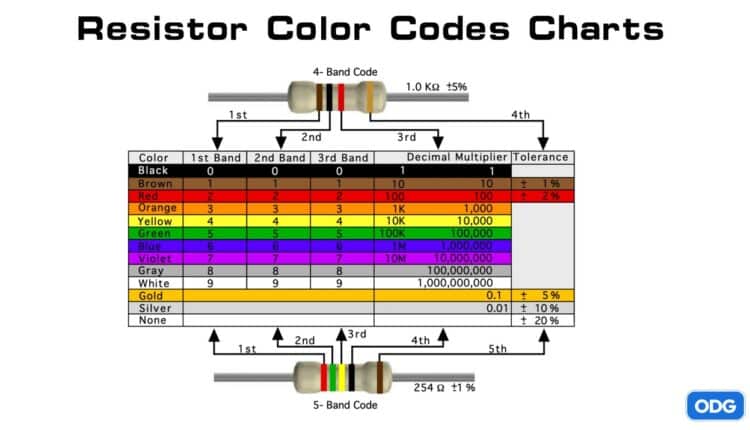Mastering Resistor Color Codes: A Comprehensive Guide for Engineers and Hobbyists
When working with electronic circuits, understanding resistor color codes is essential. Each resistor has colored bands that indicate its resistance, tolerance, and sometimes temperature coefficient. Decoding these bands manually can be time-consuming and prone to error, especially when dealing with complex circuits or high-precision components. This is where ODG’s Resistor Color Code Calculator becomes an indispensable tool. Whether you are a hobbyist building a small project or a professional engineer designing industrial electronics, this calculator simplifies the process and ensures accuracy.
What Are Resistor Color Codes?
Resistor color codes are a standardized system used to denote the resistance value of a resistor. Each resistor features multiple colored bands, and each color corresponds to a specific number, multiplier, or tolerance. The arrangement and number of bands can vary depending on the resistor type, but the principle remains consistent. Correctly interpreting these codes is crucial for circuit performance, as using the wrong resistor can lead to device failure or inefficient operation.
Types of Resistors and Their Color Bands
Resistors are typically classified by the number of color bands they possess:
- 4-band resistors: The first two bands indicate significant digits, the third is the multiplier, and the fourth represents tolerance.
- 5-band resistors: The first three bands indicate significant digits, the fourth is the multiplier, and the fifth shows tolerance.
- 6-band resistors: These include the first three significant digits, a multiplier, tolerance, and a temperature coefficient band for precise applications.
Each type provides different levels of accuracy and reliability, making it important to choose the right resistor for the task.
Why Using a Resistor Color Code Calculator Matters
Decoding resistor color codes manually can be challenging, especially for 5-band and 6-band resistors. Misreading a single band could result in choosing a resistor with the wrong value. ODG’s Resistor Color Code Calculator eliminates this risk by providing an easy-to-use online interface. Simply select the colors on the resistor, press enter, and the calculator instantly displays the resistance value in ohms (Ω). If applicable, it also provides tolerance and temperature coefficient information.
This tool is particularly beneficial for:
- Hobbyists building DIY electronics
- Engineers designing complex circuits for industrial applications
- Quality control teams verifying components
- Anyone managing a large inventory of resistors
By streamlining the process, the calculator saves time and enhances precision, ensuring circuits function as intended.
How to Read a Resistor Using Color Codes
Reading a resistor using color codes involves identifying each band and translating its color to a numerical value:
- Identify the bands: Resistors usually have a sequence of colored bands, separated by a gap from the last band.
- Assign values to colors: Each color represents a specific digit (e.g., brown = 1, red = 2, orange = 3).
- Calculate resistance: Use the values from the first bands as significant digits, multiply by the multiplier, and account for tolerance.
- Verify with a calculator: Tools like ODG’s Resistor Color Code Calculator make this step instantaneous, reducing the chance of human error.
This method ensures that you select the correct resistor for your circuit every time.
Applications of Resistors Across Industries
Resistors play a critical role in controlling current flow and dividing voltage in circuits. Their applications span multiple industries:
- Consumer electronics: Smartphones, laptops, and home appliances rely on resistors for safe and efficient operation.
- Industrial automation: High-precision resistors are used in sensors, controllers, and machinery to maintain reliability.
- Automotive electronics: Vehicles utilize resistors in control units, lighting systems, and infotainment devices.
- Renewable energy systems: Resistors are critical for managing current in solar panels and wind turbines.
Understanding the correct resistor value through color codes is essential for optimal performance in all these applications.
Choosing the Right Resistor: Factors to Consider
When selecting resistors, it’s important to consider more than just resistance. Key factors include:
- Tolerance: Indicates how much the actual resistance can deviate from the stated value. Lower tolerance is preferred for precision circuits.
- Temperature coefficient: Critical for applications exposed to varying temperatures; it measures how resistance changes with temperature.
- Power rating: Ensures the resistor can handle the energy it dissipates without overheating.
- Type of resistor: Carbon film, metal film, and wire-wound resistors have different characteristics suitable for specific applications.
ODG’s calculator covers all major types, allowing users to account for these parameters easily.
Enhancing Accuracy and Efficiency in Circuit Design
Manually calculating resistor values is not only time-consuming but also increases the likelihood of error. By using a resistor color code calculator, engineers and hobbyists can:
- Quickly identify the correct resistor for each circuit
- Reduce errors in complex designs
- Save time during assembly and testing
- Improve reliability and performance of electronic systems
For large-scale industrial projects or detailed scientific studies, this tool is invaluable.
ODG’s Commitment to Quality and Innovation
ODG is a trusted provider of electronic components, serving a global customer base with millions of parts. Their commitment to quality is demonstrated through a stringent QA system, professional QC team, and memberships in organizations such as ERAI. ODG also holds certifications including ESD, AS9120B, ISO9001, and ISO14001.
What sets ODG apart is its experienced staff who combine industry knowledge with years of hands-on experience, providing tailor-made solutions to meet unique customer needs. With tools like the Resistor Color Code Calculator, ODG ensures precision, reliability, and efficiency for both hobbyists and professional engineers.
Looking Ahead: Trends in Resistor Technology
Resistor technology continues to evolve, with trends focusing on:
- Higher precision resistors for advanced electronics
- Compact resistors suitable for miniaturized circuits
- Enhanced thermal stability for harsh environments
- Integration with smart circuit design tools
By staying informed about these developments, engineers can design more reliable and efficient electronic systems.
Follow ODG:
YouTube: https://www.youtube.com/@Origin_Data
Facebook: https://www.facebook.com/OriginDataGlobalLimited
Twitter: https://twitter.com/Origin_IC
Tiktok: https://www.tiktok.com/@origin_data
Szxlxc: https://www.szxlxc.com


